HOW FUTURE LEADERS ANSWERED THE CALL OF DUTY
World War II swept up millions of lives, including many young men who would one day shape America at its highest levels. When duty called, seven future commanders-in-chief answered. From the Pacific to the European theater, their paths crossed with history. This is the story of the US Presidents who served in WWII.
DESTINED FOR GREATNESS
Long before ascending to the Oval Office, they were sailors, soldiers and airmen carrying out critical missions overseas. Some enlisted right after Pearl Harbor, barely adults. Others had already achieved success when they volunteered to fight. Most saw active combat, displaying the courage under fire that foreshadowed their future leadership.
Combined, these seven presidents gave over a century of service guiding the nation. But in the midst of a terrible war, they were simply patriots risking their lives for freedom’s cause. As the last of the WWII generation passes from living memory, we remember their call to duty over 75 years ago.
CAPTAIN RONALD REAGAN – FROM SILVER SCREEN TO TRAINING FILMS
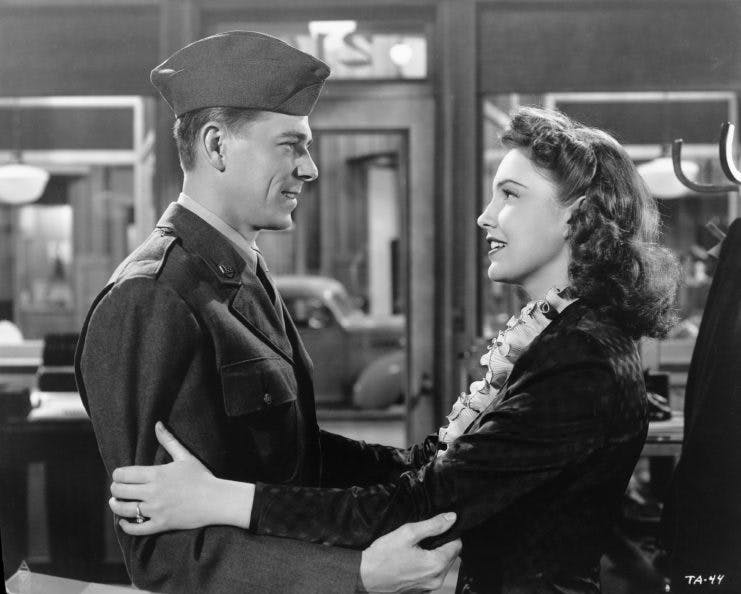
(Photo Credit: George Rinhart / CORBIS / Getty Images)
Ronald Reagan’s poor eyesight kept him away from the front lines, but his penetrating vision for America would redefine conservatism. In 1937, he enlisted in the Army Reserve Cavalry. After Pearl Harbor, Reagan was called up to active duty assigned to the Army Air Forces’ First Motion Picture Unit, making him one of the presidents who served in World War II.
The budding Hollywood star appeared in over 400 training films for deploying troops. One clip prepared machine gunners for the grisly sight of fallen comrades. In another, Reagan instructed pilots on how to scramble safely. He likewise promoted war bonds in films like the 1943 “This is the Army.” Military PR kept Reagan state-side, but he exited the Army a captain in 1945.
LIEUTENANT GERALD FORD – ALL HANDS ON DECK

Gerald Ford had barely opened his new Michigan law practice when Japanese planes bombed Pearl Harbor. The attack prompted Ford to enlist in the U.S. Naval Reserve in early 1942; another one of the Presidents who served in WWII. After being commissioned an ensign, Ford reported to the crew of the aircraft carrier USS Monterey as the ship’s athletic officer. For much of 1943, he oversaw deck operations as the Monterey participated in major Pacific actions from the Gilbert Islands to the Philippines.
The future president also coached all-star basketball teams that entertained troops across the Pacific. He later transferred to Navy Pre-Flight School before leaving active duty in late 1944. The war interrupted Ford’s legal career, but illuminated his path to Washington.
LIEUTENANT COMMANDER RICHARD NIXON – POKER-FACED RESOLVE
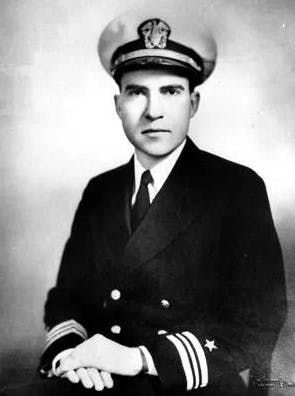
Though his Quaker upbringing entitled him to a draft exemption, Richard Nixon volunteered for the Navy immediately after Pearl Harbor. After a year of administrative roles, Nixon yearned for more and applied for sea duty in the South Pacific. As an officer with Air Transport Command, Nixon developed a reputation for keeping calm during enemy attacks.
Once, after his transport plane took heavy fire and crash-landed with two dead engines, Nixon snatched his poker winnings before exiting and ordered whiskey for the shocked crew. The future president displayed similar poise throughout his political career. For his wartime merits, Nixon received a Commendation Ribbon when he left active duty in 1946.
SILVER STAR RECIPIENT LYNDON B. JOHNSON – SURVEYING THE STAKES
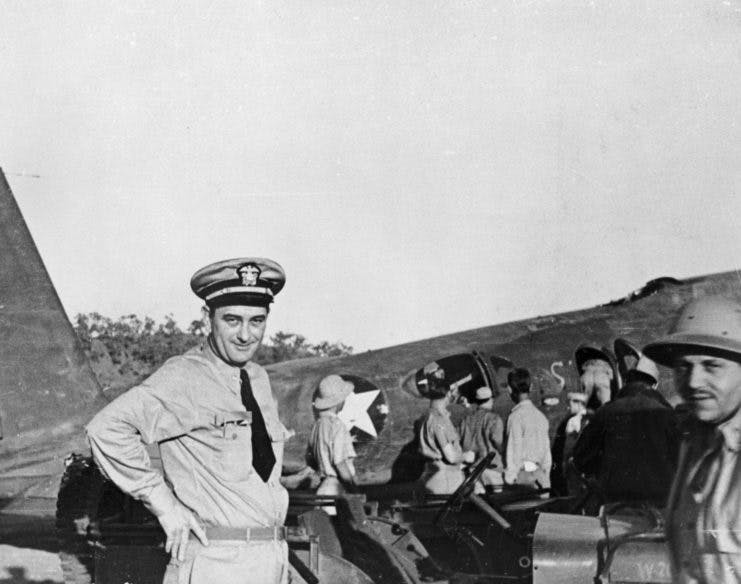
(Photo Credit: Fotosearch / Getty Images)
Despite already serving in Congress, Lyndon B. Johnson answer his reserve duty call-up just days after the Pearl Harbor attack. An influential Congressman, Johnson secured a role surveying combat readiness in the Southwest Pacific for FDR. General Douglas MacArthur tasked him with assessing conditions for air raid missions over New Guinea and Australia.
During one harrowing flight, Johnson’s B-26 came under heavy fire – losing an engine with the pilot injured and crew dead. Rushing to grab the controls amidst smoke and chaos, Johnson helped stabilize the plane and saved those onboard. His valor earned the Silver Star. Throughout his tour, the future president grasp the enormity of war’s stakes.
DISTINGUISHED NAVY PILOT GEORGE H.W. BUSH – STARING DOWN DEATH
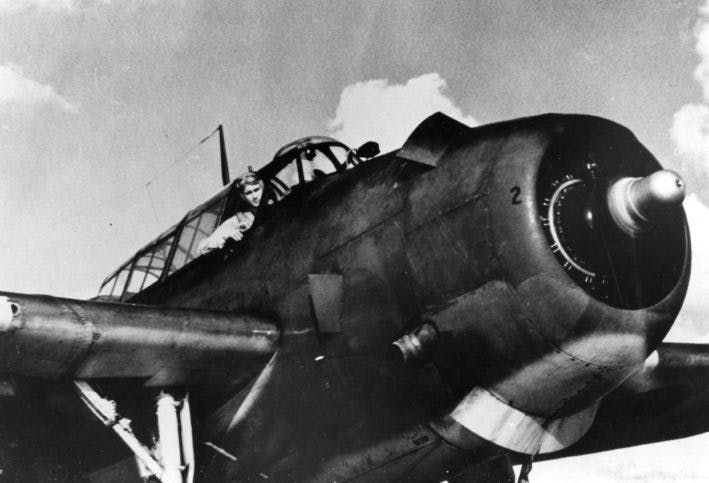
(Photo Credit: MPI / Getty Images)
Just 18 when he enlisted, combat flying appealed to George H.W. Bush’s youthful daring. On his 19th birthday – June 12, 1943 – Bush was commissioned an ensign and underwent flight training. A year later in June 1944, Bush began attacking Japanese positions, launching bombing raids on Pacific islands. He flew his first 58 missions aboard the light carrier USS San Jacinto as part of Air Group 51.
In early September, Bush’s TBM Avenger torpedo bomber was hit during an assault on Chichijima Island, 600 miles from Japan. With his engine ablaze, Bush dropped his four 500 lb bombs before bailing out over the water. Floating for four hours, Bush was eventually rescued by a US submarine. For his skill and bravery, Bush received a Distinguished Flying Cross. But he was lucky to survive. Most other pilots shot down that day were executed and eaten by Japanese troops.
WAR HERO JFK – THE SAGA OF PT-109
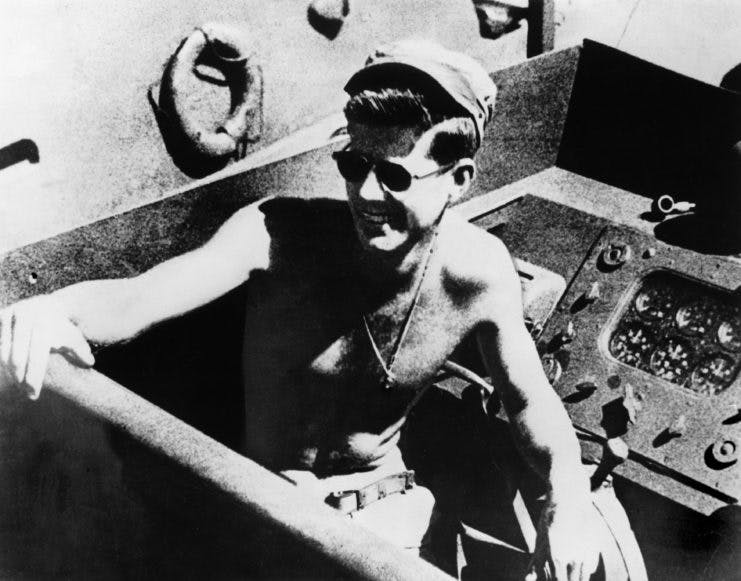
(Photo Credit: Keystone-France / Gamma-Keystone / Getty Images)
Despite ongoing back problems, John F. Kennedy joined the Navy immediately after Pearl Harbor, commanding motor torpedo boats in the South Pacific. Kennedy received PT-109 – an 80-foot Elco craft – in the spring of 1943 near the Solomon Islands. Just months later in August, a Japanese destroyer traveling with no lights smashed Kennedy’s boat, slicing it in half. Two men died as the 11 survivors clung to wreckage for hours in shark-filled waters.
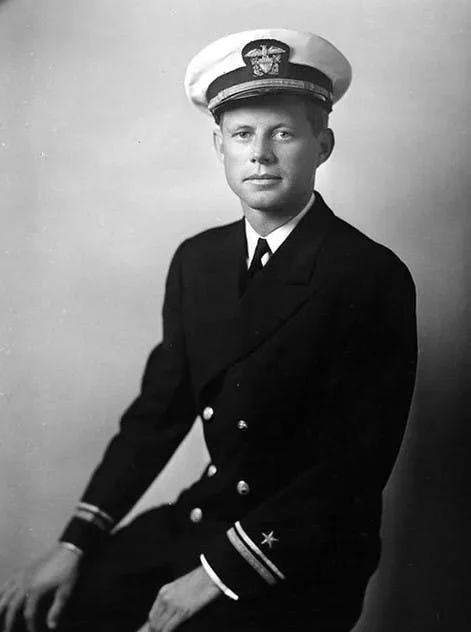
As rescue seemed doubtful, Kennedy rallied his men to follow him on a risky 3.5 mile swim to an island two days later. Along the way, he towed a badly burnt sailor by clenching his lifejacket strap in his teeth. Once ashore, Kennedy exchanged messages in a carved coconut before securing an eventual rescue. Though PT-109 was lost, Kennedy earned medals for his leadership and courage. His story peaked public interest – helping him win the presidency 17 years later.
SUPREME COMMANDER DWIGHT EISENHOWER – ARCHITECT OF D-DAY
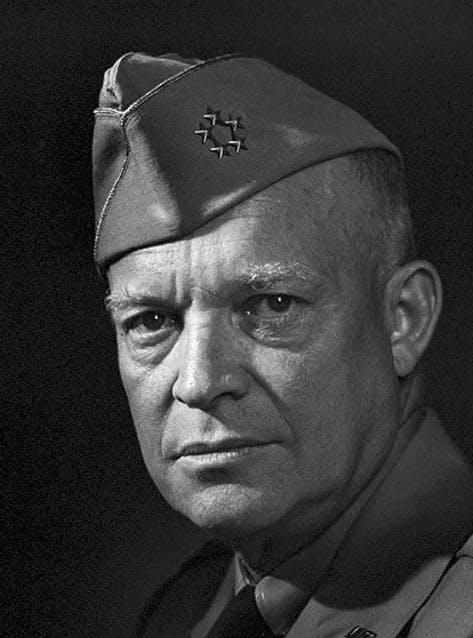
Unlike the others, five-star General Dwight Eisenhower entered WWII with immense military experience spanning decades. By 1942, he commanded all Allied expeditions in Europe. In 1943, President Roosevelt picked him as Supreme Commander of the impending Allied invasion of France – codenamed Operation Overlord.
From headquarters in London, Eisenhower meticulously planned the June 6, 1944 landings across 50 miles of Normandy beaches. He faced immense pressure knowing failure could doom the Allies’ position. Final authorization for the massive invasion ultimately came from Eisenhower. His D-Day command oversaw the beginning of the end of Hitler’s grip on Europe. For prominent Americans of his generation, WWII service represented a unifying trial – one that seven future presidents all passed.



